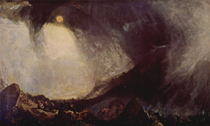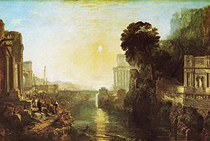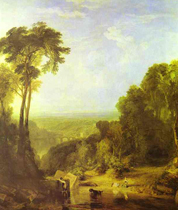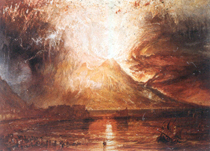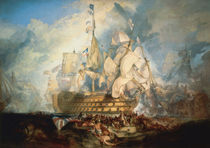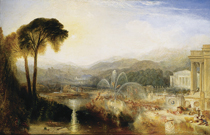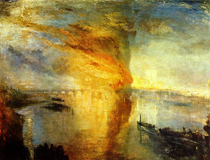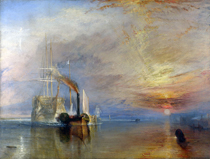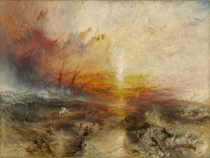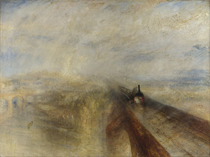Joseph Mallord William Turner was born in Covent Garden, London, in 1775. In 1789, at the age of 14, he entered the Royal Academy of Art and one year later his watercolour painting A View of the Archbishop's Palace, Lambeth was accepted for exhibition.
As a young man Turner travelled Europe and spent some time studying in the Louvre, Paris, before returning to Britain to pursue his career.
Turner was thought of as a controversial man during his life. He had few close friends and never married, although he is thought to have been the father of two daughters born to his lover, Sarah Danby.
[readmore]
Turner is considered to be the master of British watercolour landscapes and he is responsible for the popularisation of this genre, giving it equal status to the more widely accepted historical paintings.
Turner died on the 19th of December 1851, aged 76. His last words were "The Sun is God". He is buried in Saint Paul's Cathedral next to one of the founding members of the Royal Academy, Sir Joshua Reynolds.
[/readmore]
For a closer look at the pictures, please click on them to enlarge.
|
1.
|
This painting of 1812 depicts which historical character attempting to cross the Alps? ![]()
|
|
| [ ] |
Julius Caesar |
| [ ] |
Hannibal |
| [ ] |
Alexander the Great |
| [ ] |
Charlemagne |
|
|
|
2.
|
Also known as The Rise of the Carthaginian Empire this painting shows the ancient city of Carthage being built by which legendary figure? ![]()
|
|
| [ ] |
Helen |
| [ ] |
Hannibal |
| [ ] |
Dido |
| [ ] |
Aeneas |
|
|
|
3.
|
First exhibited in 1815, Crossing the Brook is thought to be of which river, which can be found in both Devon and Cornwall? ![]()
|
|
| [ ] |
Parrett |
| [ ] |
Taw |
| [ ] |
Exe |
| [ ] |
Tamar |
|
|
|
4.
|
One of Turner's historical works, this is a depiction of which volcano erupting? ![]()
|
|
| [ ] |
Vesuvius |
| [ ] |
Krakatoa |
| [ ] |
Stromboli |
| [ ] |
Etna |
|
|
|
5.
|
The Battle of Trafalgar was painted by Turner in 1824 at the request of which British monarch? ![]()
|
|
| [ ] |
George III |
| [ ] |
George IV |
| [ ] |
William IV |
| [ ] |
Victoria |
|
|
|
6.
|
Inspired by a 1748 poem by James Thomson, what is the title of this piece first exhibited in 1834? ![]()
|
|
| [ ] |
The Fountain of Ignorance |
| [ ] |
The Fountain of Folly |
| [ ] |
The Fountain of Indolence |
| [ ] |
The Fountain of Faith |
|
|
|
7.
|
This is one of two paintings by Turner showing which London landmark aflame? ![]()
|
|
| [ ] |
Saint Paul's Cathedral |
| [ ] |
Buckingham Palace |
| [ ] |
Westminster Abbey |
| [ ] |
The Houses of Parliament |
|
|
|
8.
|
In a 2005 poll conducted by BBC Radio 4's Today programme, The Fighting Temeraire of 1838 was voted to which position? ![]()
|
|
| [ ] |
The UK's favourite painting |
| [ ] |
The UK's second favourite painting |
| [ ] |
The UK's third favourite painting |
| [ ] |
The UK's fourth favourite painting |
|
|
|
9.
|
Slavers Throwing Overboard the Dead and Dying—Typhoon Coming On shows a restless sea laden with human forms. These have been cast overboard from the ship which can be seen in the background. What is the more common and less formal name of this painting which was created in 1840? ![]()
|
|
| [ ] |
The Typhoon |
| [ ] |
Overboard |
| [ ] |
The Slave Ship |
| [ ] |
Adrift |
|
|
|
10.
|
Painted around 1844, Rain, Steam and Speed has the name of which 19th century company as its subtitle? ![]()
|
|
| [ ] |
Stockton and Darlington Railway |
| [ ] |
The Great Western Railway |
| [ ] |
Midland & South West Junction Railway |
| [ ] |
London, Midland and Scottish Railway |
|
|
|
1.
|
This painting of 1812 depicts which historical character attempting to cross the Alps? ![]()
|
|
| [ ] |
Julius Caesar |
| [x] |
Hannibal |
| [ ] |
Alexander the Great |
| [ ] |
Charlemagne |
|
|
|
2.
|
Also known as The Rise of the Carthaginian Empire this painting shows the ancient city of Carthage being built by which legendary figure? ![]()
|
|
| [ ] |
Helen |
| [ ] |
Hannibal |
| [x] |
Dido |
| [ ] |
Aeneas |
|
|
|
3.
|
First exhibited in 1815, Crossing the Brook is thought to be of which river, which can be found in both Devon and Cornwall? ![]()
|
|
| [ ] |
Parrett |
| [ ] |
Taw |
| [ ] |
Exe |
| [x] |
Tamar |
|
|
|
4.
|
One of Turner's historical works, this is a depiction of which volcano erupting? ![]()
|
|
| [x] |
Vesuvius |
| [ ] |
Krakatoa |
| [ ] |
Stromboli |
| [ ] |
Etna |
|
|
|
5.
|
The Battle of Trafalgar was painted by Turner in 1824 at the request of which British monarch? ![]()
|
|
| [ ] |
George III |
| [x] |
George IV |
| [ ] |
William IV |
| [ ] |
Victoria |
|
|
|
6.
|
Inspired by a 1748 poem by James Thomson, what is the title of this piece first exhibited in 1834? ![]()
|
|
| [ ] |
The Fountain of Ignorance |
| [ ] |
The Fountain of Folly |
| [x] |
The Fountain of Indolence |
| [ ] |
The Fountain of Faith |
|
|
|
7.
|
This is one of two paintings by Turner showing which London landmark aflame? ![]()
|
|
| [ ] |
Saint Paul's Cathedral |
| [ ] |
Buckingham Palace |
| [ ] |
Westminster Abbey |
| [x] |
The Houses of Parliament |
|
|
|
8.
|
In a 2005 poll conducted by BBC Radio 4's Today programme, The Fighting Temeraire of 1838 was voted to which position? ![]()
|
|
| [x] |
The UK's favourite painting |
| [ ] |
The UK's second favourite painting |
| [ ] |
The UK's third favourite painting |
| [ ] |
The UK's fourth favourite painting |
|
|
|
9.
|
Slavers Throwing Overboard the Dead and Dying—Typhoon Coming On shows a restless sea laden with human forms. These have been cast overboard from the ship which can be seen in the background. What is the more common and less formal name of this painting which was created in 1840? ![]()
|
|
| [ ] |
The Typhoon |
| [ ] |
Overboard |
| [x] |
The Slave Ship |
| [ ] |
Adrift |
|
|
|
10.
|
Painted around 1844, Rain, Steam and Speed has the name of which 19th century company as its subtitle? ![]()
|
|
| [ ] |
Stockton and Darlington Railway |
| [x] |
The Great Western Railway |
| [ ] |
Midland & South West Junction Railway |
| [ ] |
London, Midland and Scottish Railway |
|
|
